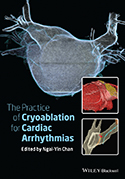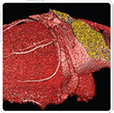
The Practice of Catheter Cryoablation for Cardiac Arrhythmias
Edited by Ngai-Yin Chan


Cases
Case 6.2. Prevention of phrenic nerve palsy during cryoballoon ablation for atrial fibrillation
A 54-year-old woman underwent pulmonary vein isolation using cryoballoon ablation for symptomatic paroxysmal atrial fibrillation. During the ablation of the right-sided pulmonary veins, the phrenic nerve function was monitored by pacing the nerve from the superior vena cava at 10 mV at 1 ms and palpating the diaphragmatic exertion. Twenty seconds into the ablation of the right inferior pulmonary vein, the exertion of the diaphragm became weaker. (See also Video Clip 6.1.)
-
1. What is the next best step – continue ablation until the diaphragmatic excretions stop, reposition the pacing catheter as it most likely dislodged, increase the pacing current to 20 mV at 1 ms, or immediately terminate ablation and assess antral position of the balloon?